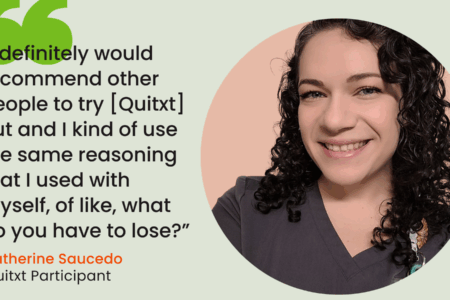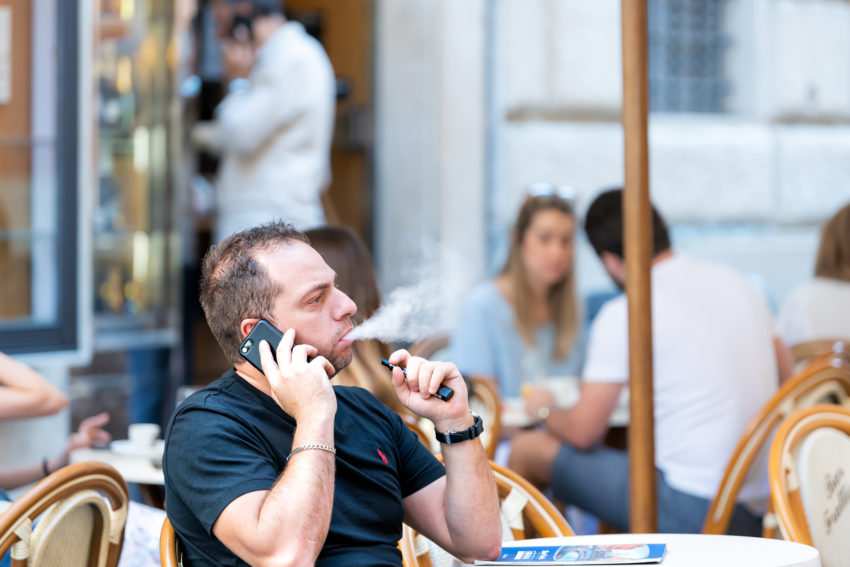
Share On Social!
Since the start of the pandemic, many health experts say smoking and vaping increase the risk of COVID-19.
This happens by weakening the function of the lungs making it more susceptible to coronavirus — as well as its overall impacts.
Moreover, new data from Stanford University shows that young people who vape are more susceptible to COVID-19 than those who do not.
That data—collected from a May 2020 national survey of 13- to 24-year-olds—showed that vapers are five times more likely to get COVID-19. Many cities and states across the US are passing bans on flavored vaping products during the COVID-19 pandemic.
Flavored Vaping Bans Across the Country
Last month the California State Assembly passed a ban on the sale of flavored tobacco products, including e-cigarettes and vapes.
Recently Chicago also passed bans on sales of flavored vaping products. On Sept. 8, Florida Governor Ron DeSantis vetoed a bill that would have banned all flavored vaping products, except tobacco and menthol flavors.
In 2019, New York became the first state to implement a statewide ban on most flavored nicotine vaping products.
In late September, Massachusetts went a four-month prohibition on the sale of all vaping products, further than any other state in an urge to keep e-cigarettes out of consumers’ hands, with its governor declaring a public health emergency and order.
In October, Rhode Island introduced a 120-day ban on flavored vaping products, not including unflavored tobacco products, with an option to extend the prohibition another 60 days.
How Can These Flavored Vaping Ban Can Help Latinos?
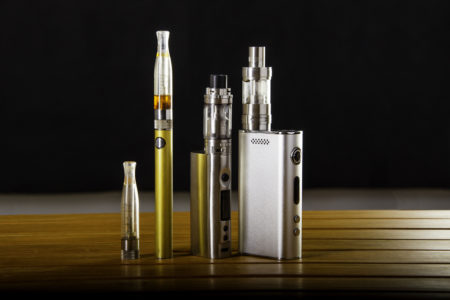 Latino adults smoke cigarettes at a lower rate (12.1%) than their white peers (19.4%).
Latino adults smoke cigarettes at a lower rate (12.1%) than their white peers (19.4%).
However, once they’ve started, Latinos are more likely to keep smoking and only half as likely as whites to successfully quit smoking. Hence, Latinos find it harder to quit smoking.
Moreover, e-cigarettes and other flavored are the most commonly used tobacco products among Latino youths.
According to the latest CDC report, most youth e-cigarette users report using flavored varieties. Among high school students who currently use any flavored e-cigarettes, the most commonly used flavors are fruit (73%), mint (56%), menthol (37%), and candy, desserts, or other sweets (36.4%).
California, Chicago, and Florida have a higher Latino population, and Latinos have seen disproportionately high COVID-19 diagnoses.
While the elderly are highly susceptible to the coronavirus COVID-19, young adults aren’t off the hook, either.
The COVID-19 pandemic has affected Latinos who have worsening health inequities, disparities in exposure, testing, prevention and treatment, and job impact. Hence, everyone needs to understand the risk and behave accordingly.
How Are Vapers More Susceptible to Coronavirus (COVID-19)?
Many studies have already shown that smoking is associated with a substantially higher risk of COVID-19 progression. The current research, for the first time, examines the genetic and molecular biological connections between youth vaping and COVID-19.
Many experts believe ACE2, an enzyme that lives on the surface of many cells in the lung, serves as the entry point for the coronavirus in the lungs and severe consequences of COVID-19 feature pneumonia and affects the lung function, and is especially problematic for those with weak lung or immune systems.
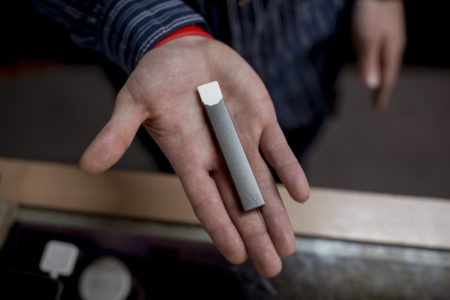
A recent study from University of Rochester Medical Center focuses on the vital role of ACE2, an enzyme that lives on the surface of many cells in the lung, “to shape a clearer picture of the critical cellular mechanisms that regulate the deadly virus and its link to vaping.”
“Our next step is to investigate whether ACE2 is normally low in young people, hence their relatively low infection and mortality rates from COVID-19, but to find out if ACE2 is increased by smoking or vaping, rendering them more susceptible to the virus,” said Rahman, Dean’s Professor of Environmental Medicine, Medicine (Pulmonary), and Public Health Sciences, to press release. “This would be in contrast to older people with lung diseases such as COPD and pulmonary fibrosis, who we already know are at higher risk for severe viral illnesses and death.”
All Smokers and Those Exposed to Secondhand Smoke May Have Higher COVID-19 Risk
Those who quit smoking for a month also had lower ACE2 levels, according to Alen Faiz of Australia’s University of Technology Sydney.
“Our preliminary data suggest that secondhand smoke exposure of 1-year-old children…increased ACE2 expression in their airways,” he said.
A study by Faiz and other Australian scientists found that smoking just three cigarettes can activate a spell of increased activity in the part of the genome that codes for a protein known as ACE2.
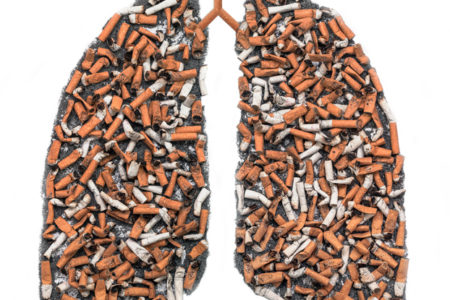
Studies also show that secondhand smoke and thirdhand smoke may be linked to COVID-19 Transmission.
A study published in The Lancet Respiratory Medicine suggests no safe level of tobacco smoke exposure and that smoking cessation is the most effective means of harm reduction.
According to the research published in the Journal of Adolescent Health, 1 in 3 young adults is at risk of severe COVID-19, and smoking plays a big part in that risk.
Vinayak Prasad, program manager leading the WHO’s Tobacco Free Initiative, told Politico EU, “it’s a no brainer that the severity of infection would be higher among long-standing smokers, especially if they have comorbidities.”
Why Are These Studies and Flavored Vaping Bans Important Now?
New CDC data now says 33% of US high school students-1 in 3!!-used e-cigarettes in 2019- up from 13% in 2017.
‘They may believe their age protects them, or they will not experience symptoms, but the data show this isn’t true among those who vape’ said Dr. Shivani Mathur Gaih, lead author of the new study from Stanford University that studied among the teens who smoke and also vape.
As the popularity of e-cigarettes has surged in recent years, so has the public’s confusion over the health risks these products pose. The US surgeon general called teen vaping a national health epidemic.
Currently, all universities are opening for the fall semester, and more schools are reporting more new cases of COVID-19. It is essential the University takes necessary steps and promotes healthy behaviors in youngsters.

Purdue University administration is warning students that sharing vaping devices has been linked to coronavirus cases on campus.
Purdue University released the critical statement last week, “The sharing of vaping devices is believed to be the cause of certain spread of COVID-19 at Purdue University to date, particularly within congregate housing such as fraternities, sororities, and cooperative houses.”
You can read the full statement from the university here.
Other universities and education institutions should come forward and help the students to understand the risk of vaping and smoking and their role in the COVID-19 outbreak.
“I think that a sensible thing to do for people is to stop smoking and stop vaping—and avoid secondhand exposure,” says Stanton Glantz, director of the Center for Tobacco Control Research and Education at the University of California, San Francisco said in a press release.
‘Quitxt’ Can Help You Quit Smoking amid COVID-19 Pandemic
Quitxt is a bilingual service for your smartphone that sends messages with culturally and regionally tailored support can help you in quitting smoking and vaping
The service uses text messages or Facebook Messenger chat to help with motivation to stop, setting a quit date, finding things to do instead of smoking, handling stress, using nicotine replacement if needed, and more.
The service was created by Amelie G. Ramirez, leader of Salud America! at the Institute for Health Promotion Research at UT Health San Antonio and has helped many South Texas young adults to quit smoking.
Join Quitxt via Facebook Messenger, just hit “send message”!
Learn more about Quitxt message program in English or Spanish to help you quit smoking today!
By The Numbers
142
Percent
Expected rise in Latino cancer cases in coming years



